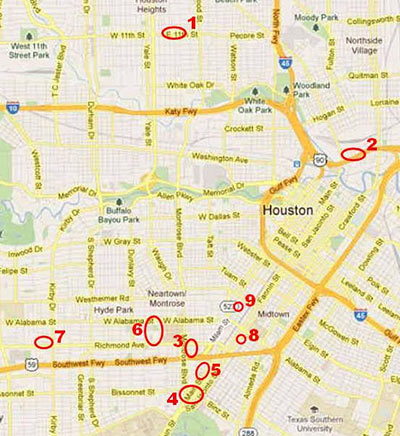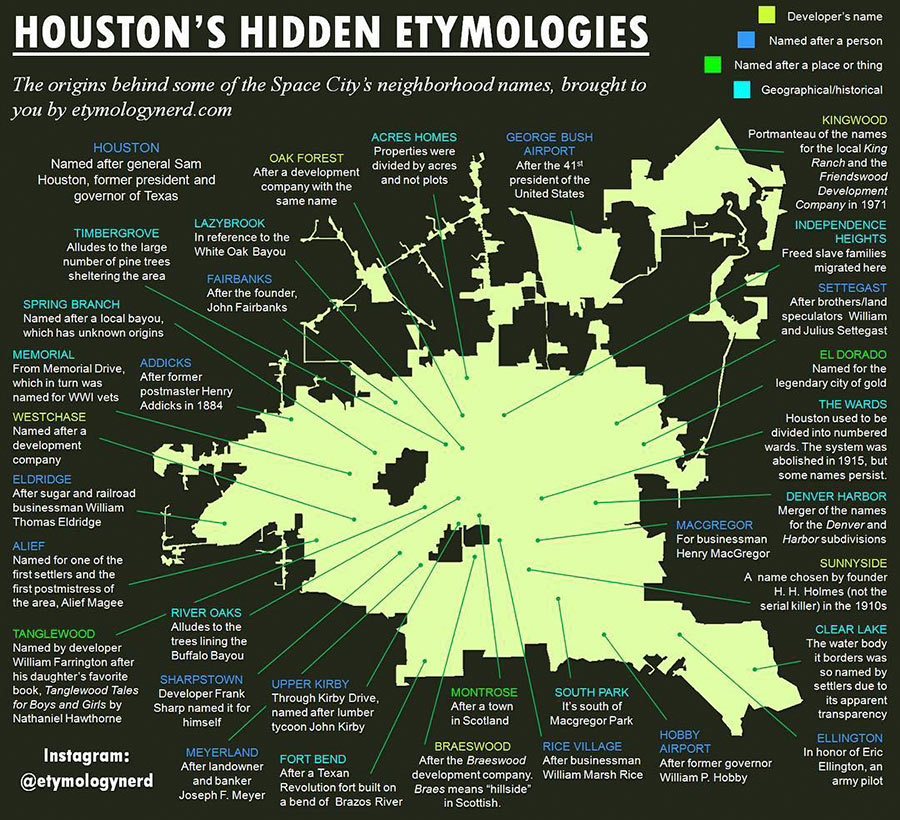
Art galleries that are within sight and walking distance of other art galleries might do better than standalone spaces, guesses blogger Robert Boyd after mapping the somewhat clustered Inner Loop locations of Houston’s 9 art-gallery clusters (above): “Since I started this blog, none of the institutions in clusters have shut their doors except for Joan Wich’s gallery, which died when she did. But isolated, non-clustered institutions have had problems.” Call it Houston’s might-as-well effect: “Visiting an art gallery or museum generally requires someone drive (or bike) to it–to make a dedicated trip, in other words. But if there is a second gallery there, the marginal effort required to visit the second art space is practically nil. Might as well, right?”
- Clusters [The Great God Pan Is Dead]
Map: Robert Boyd





Generally speaking, it makes sense to open a business near another established business in the same market. Given that a customer already going to your competitor’s store is looking for that sort of product, it’s not a leap for them to go across the street to you. Whereas, if you were a few miles away, they’d have to already know about you in some other way.
Ever notice how other furniture stores pop up around the one doing the most TV ads? Usually within visible distance from the main roadway…
Yes, in the field of urban economics describes the phenomenon as “economies of agglomeration”.
The same principle holds true for art galleries as holds true for auto dealerships, hardware stores, mall department stores, and gay bars, and can also apply to labor markets between cities and within cities’ neighborhoods.
It seems to me that this would work best where the retail establishments are not competing on price. For example, two supermarkets might not want to set up right next to one another. Better instead to have two stores selling in the same category but with different selections of product (art galleries, dress shops) or in complimentary categories (dress shop next to a shoe store), right?
Niche: you left masssage establishments off your list…..
This is interesting. Has any urban economist studied the co-location of non-profits such as museums or galleries. Do they have the same economies of location as retail?
I’m not sure about the economies, but usually if I am visiting the MFAH, I’ll also peek into the CAMH and vice versa.
Art galleries do best when they are located in areas with other art galleries. They sort of support each other in the PT Barnum method of market manipulation. As in “the more you pay, the more valuable it is.” Very often the “private collections” the artist supposedly is part of is the different shelves in the gallery owner’s garage. Please. People don’t buy this crap and then talk about the intrinsic aesthetics of the piece. They talk about how much they paid for it at which gallery. Whether it’s Houston or New York or Los Angeles or San Francisco the motto of the gallery owner is the same. “There’s a sucker born every minute.” And it’s good for business when you can draw all the suckers into the same area. Makes it more likely sooner or later one of them will buy your crap.
Most galleries don’t represent someone else’s private collection. At least, most in Houston don’t. I’m not sure where you get this fact. The work is usually consigned to the gallery by the artist and sold on a 50/50 basis. Sometimes, galleries pay their artists a stipend to support them as they produce work for their next show. Artworks are certainly something that people buy to impress other people with their taste and wealth (as Thorstien Veblen wrote about over a hundred years ago in Theory of the Leisure Class), but believe it or not, some people buy artworks because they like them. And some art dealers don’t think of their clients as suckers. Indeed, I’d venture to guess that most art dealers get into the business because they like art! It can’t be the money–running an art gallery is like running a restaurant: they’re both notoriously risky ventures.
I didn’t say gallery owners represented private collectors but rather often represented that their artists were collected by private collectors. All of whom of course don’t wish to be identified. Lest the art thieves know who they are. As for those with the private collections they usually sell through the auction houses. Which also follow the maxims of PT Barnum.
I had friends in Los Angeles years ago who couldn’t resist La Cienega. And had the walls to prove it. The loved their modern art. Their ten year old decided he would become an artist. So they indulged him. On a lark they started hanging their son’s art on the walls. And soon guests who didn’t know started asking where they had bought the paintings and who this “Abraham” was. Their son signed his work with just his first name. So they had some fun with the “up and coming artist they discovered.” And a couple of people offered a small fortune for his work. Aesthetics is of course in the eye of the beholder. Value is in the pocketbook of the buyer. Some do well with it. Buying and selling it. Laughing all the way to the bank. Some, however, don’t. And end up with a million dollars on their walls that is worth only what an auctioneer can convince someone it’s worth. Which sometimes isn’t very much.
The old “My kid could do that!” argument. Nice one.
Sure, Matt.
Great story.